The Intel Optane Memory H10 Review: QLC and Optane In One SSD
by Billy Tallis on April 22, 2019 11:50 AM ESTAnandTech Storage Bench - The Destroyer
The Destroyer is an extremely long test replicating the access patterns of very IO-intensive desktop usage. A detailed breakdown can be found in this article. Like real-world usage, the drives do get the occasional break that allows for some background garbage collection and flushing caches, but those idle times are limited to 25ms so that it doesn't take all week to run the test. These AnandTech Storage Bench (ATSB) tests do not involve running the actual applications that generated the workloads, so the scores are relatively insensitive to changes in CPU performance and RAM from a new testbed, but the jump to a newer version of Windows and newer storage drivers can have an impact.
We quantify performance on this test by reporting the drive's average data throughput, the average latency of the I/O operations, and the total energy used by the drive over the course of the test.
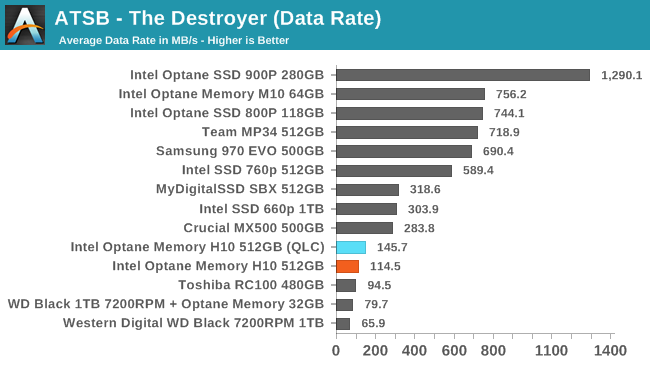
The Intel Optane Memory H10 actually performs better overall on The Destroyer with caching disabled and the Optane side of the drive completely inactive. This test doesn't leave much time for background optimization of data placement, and the total amount of data moved is vastly larger than what fits into a 32GB Optane cache. The 512GB of QLC NAND doesn't have any performance to spare for cache thrashing.

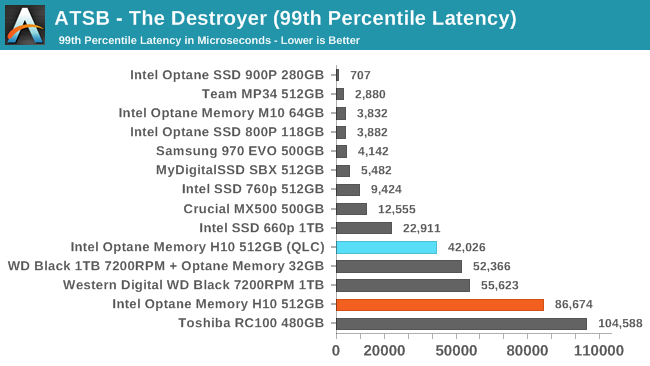
The QLC side of the Optane Memory H10 has poor average and 99th percentile latency scores on its own, and throwing in an undersized cache only makes it worse. Even the 7200RPM hard drive scores better.
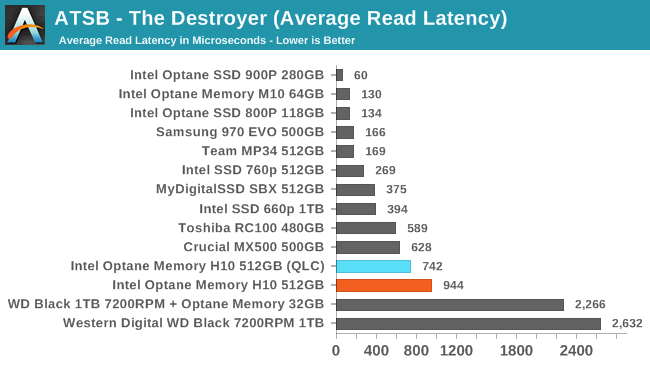
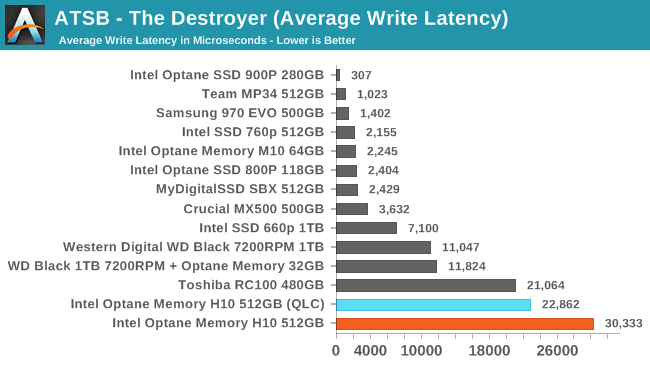
The average read latencies for the Optane Memory H10 are worse than all the TLC-based drives, but much better than the hard drive with or without an Optane cache in front of it. For writes, the H10's QLC drags it into last place once the SLC cache runs out.
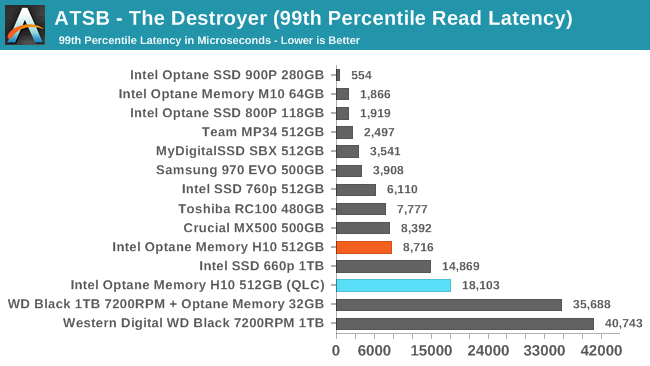
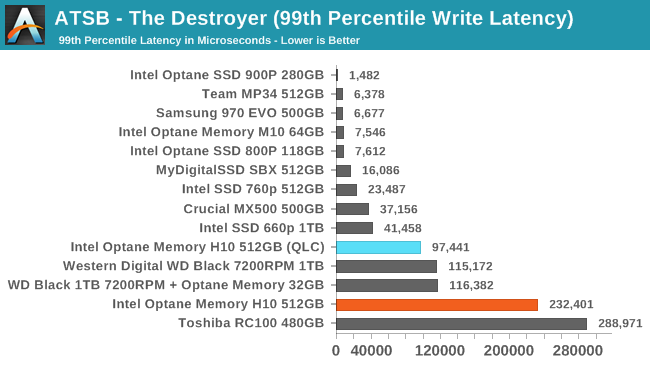
The Optane cache does help the H10's 99th percentile read latency, bringing it up to par with the Crucial MX500 SATA SSD and well ahead of the larger QLC-only 1TB 660p. The 99th percentile write latency is horrible, but even with the cache thrashing causing excess writes, the H10 isn't quite as badly off as the DRAMless Toshiba RC100.










60 Comments
View All Comments
yankeeDDL - Monday, April 22, 2019 - link
Is it me or, generally speaking, it is noticeably slower than the 970 Evo?DanNeely - Monday, April 22, 2019 - link
The 970 can make use of 4 lanes, with only 2 effective lanes in most scenarios any good x4 drive is going to be able to smoke the H10.yankeeDDL - Monday, April 22, 2019 - link
I still remember that Optane should be 1000x faster and 1000x cheaper. It seems that it is faster, albeit by a much lower factor ... then why hamper it with a slower bus? I mean, I came to read the review thinking that it could be a nice upgrade, and then I see it beaten handily by the 970 Evo. What's the point of such device? It is clearly more complex, so I doubt it'll be cheaper than the 970 Evo...Alexvrb - Monday, April 22, 2019 - link
Wait, did they say it would be cheaper? I don't remember that. I know they thought it would be a lot faster than it is... to be fair they seemed to be making projections like NAND based solutions wouldn't speed up at all in years LOL.It can be a lot faster in certain configs (the high end PCIe add-on cards, for example) but it's insanely expensive. Even then it's mainly faster for low QDs...
kgardas - Tuesday, April 23, 2019 - link
Yes, but just in comparison with DRAM prices. E.g. NVDIMM of big size cheaper than DIMM of big size.Irata - Tuesday, April 23, 2019 - link
It was supposed to be 1000x faster and have 1000x the endurance of NAND as per Intel's official 2016 slides.It may be slightly off on those promises - would have loved for the article to include the slide with Intel's original claims.
Price wasn't mentioned.
yankeeDDL - Tuesday, April 23, 2019 - link
You're right. They said 1000x faster, 1000x endurance and 10x denser, but they did not say cheaper, although, the 10x denser somewhat implies it (https://www.micron.com/~/media/documents/products/... Still, this drive is not faster, nor it has significantly higher endurance. Let's see if it is any cheaper.Valantar - Tuesday, April 23, 2019 - link
Denser than DRAM, not NAND. Speed claims are against NAND, price/density claims against DRAM - where they might not be 1/10th the price, but definitely cheaper. The entire argument for 3D Xpoint is "faster than NAND, cheaper than DRAM (while persistent and closer to the former than the latter in capacity)", after all.CheapSushi - Wednesday, April 24, 2019 - link
I think this is why there's still negative impressions around 3D Xpoint. Too many people still don't understand it or confuse the information given.cb88 - Friday, May 17, 2019 - link
Optane itself is *vastly* faster than this... on an NVDIMM it rivals DDR4 with latencies in hundreds of ns instead of micro or milliseconds. And bandwidth basically on par with DDR4.I think it's some marketing BS that they don't use 4x PCIe on thier M.2 cards .... perhaps trying to avoid server guys buying them up cheap and putting them on quad m.2 to PCIe adapters.